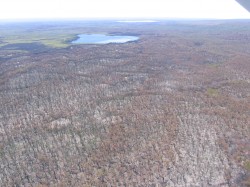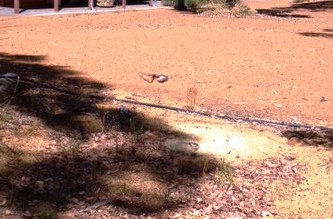
Pointed, painted Christmas stars,
flags of white marking off their boundaries.
Red-legged bellies span my early morning walk
with webs to catch my steaming breath.
Gossamer curtains fall in silken folds
to hide tunnel creatures, lurking still and quiet.
Paper-thin crevice dwellers with origami legs
defy me to believe that they are real.
As we walked towards the water tank, I beheld a stone in levitation. Pea gravel, round and brown, suspended in the early morning light. This cannot be true! An old Indian rope trick? But, no! My Indian was safe abed! I looked more closely. The pea gravel was wrapped in silk and anchored something. But, what? I stared upwards. Between two red gums, their leaves and flowers tossing like waves at sea, my spider had cast her net. Binding them together so softly they were not inhibited at all; holding them so strongly she sat athwart her steel bands with impunity.
What perfect tension – springing within my soul. Her anchor held it all – and touched nothing. How did she know? How did she do it: To raise the stone, to drop the line, to set the axis? Who told her she is to engineer, defying gravity while yet bringing it to bear, in her daily search for food? Perhaps it was she who taught the Egyptians to raise and set their great stones. She tugged at my heart, with her silken thread of miracles.
As Pepper Dog and I walked on, a sad truth was revealed. No longer did I need to brush the early morning company from my eyes and my nose. They travelled with me so infrequently in those days. No bush flies in my bush! Oh, dear God. Is this why all my spiders have gone? (Poem for Colin, Toronto, Canada Apr 94.)
Twenty years of just being there…….
The experience of seeing that small gravel stone suspended five or six feet above the ground, as the tension anchor for a web that was twenty feet above me was awe-inspiring.

By 2004, another ten years later the continuing losses were catastrophic. Turn over an old log in the bush today – and you are lucky to find a bush cockroach or two. Sadly, the simple fact that we are present in the middle of a bush block brings damaging pressure on the environment that we do not see or feel, from day to day – only when the accumulated impact is undeniable.
Gradual degradation…….

But to accelerate that loss, by uncaring and commercially motived clearing of critical feeding areas such as we are seeing around the metropolitan area of Perth now, is unacceptable and cannot be tolerated.
We can no longer occupy a space on this planet, without making a personal, individual contribution to its wellbeing. It is not enough to ‘recycle’, we must also renew, restrain and rehabilitate.
Habitat gardens and valuing our heritage……
Supporting habitat gardens in backyards and on community reserves are first steps towards repairing and healing our environment. Your habitat plants are most likely those native bushes that were thriving in your own backyard, before it was your backyard! The plants upon which our birds fed and in which they nested.

The bush fires around Nannup in the summer of 2010/2011 devastated 100,000 ha of bushland and forest. Some majestic timber areas were spared – among them the Warrup Forest Coupe and Helms Coupe.
In the 1920s, this forest area was abandoned as no longer being viable for logging, by the Mauri Timber Company. I know this because my mother’s family moved into the abandoned timber workers’ huts until their own tiny house could be built on a soldier settlement. You can read something of their story here: The Lady Who curled Ostrich Feathers
The challenge and the opportunity…..
This forest area was selectively logged – eighty years ago! Now, we have a once in a lifetime chance to preserve the trees and iconic native creatures they house and feed – the trees that were left behind 80 – 90 years ago as unviable for logging.
This is an opportunity which will never come our way again! Certainly not in our lifetime, nor that of our children and grandchildren. This is our one and only chance to save trees that are already around 200 years old and to save the habitat they create for so many unique, West Australian animals and birds.
For our black cockatoos – in particular – this is our last chance to save them! Because Black Cockatoos Are Starving In Western Australia and This Is Why Our #BlackCockatoos Are Starving!

Ask yourself: Do I Care If My Grandchildren Never See A Black Cockatoo Flying Overhead – Announcing The Impending Rain?
The challenge is to sustain our commitment to preserve, nurture and restore the habitat of wetlands and bushland both. It’s no longer a matter of being ‘a greenie’. It’s life itself, that is at stake!
About Snippets….
If you like our Snippets, join us online. Download your copy of Grrk The Motorbike Frog, and also get regular updates of new postings. Get it here, now!.
(c) Lesley Dewar July 2012 to current.





This is an extremely engaging piece Lesley . I love the way you write 🙂
Thank you Clare. We have a lot of work to do, yet and the pen is mightier than the sword.